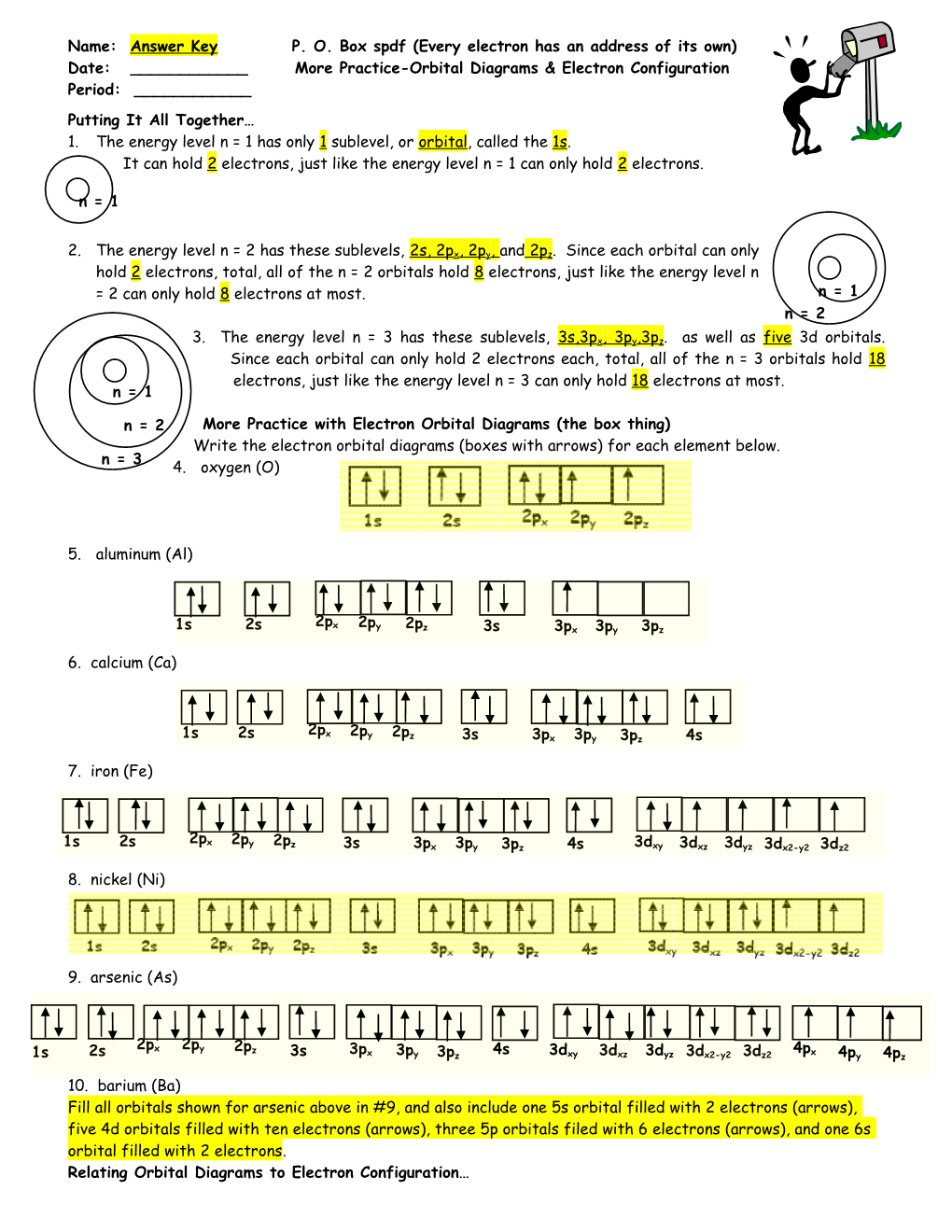Name: Answer Key P. O. Box spdf (Every electron has an address of its own)
Date: ______More Practice-Orbital Diagrams & Electron Configuration
Period: ______
Putting It All Together…
- The energy level n = 1 has only 1 sublevel, or orbital, called the 1s.
It can hold 2 electrons, just like the energy level n = 1 can only hold 2 electrons.
- The energy level n = 2 has these sublevels, 2s, 2px, 2py, and 2pz. Since each orbital can only hold 2 electrons, total, all of the n = 2 orbitals hold 8 electrons, just like the energy level n = 2 can only hold 8 electrons at most.
- The energy level n = 3 has these sublevels, 3s,3px, 3py,3pz. as well as five 3d orbitals. Since each orbital can only hold 2 electrons each, total, all of the n = 3 orbitals hold 18 electrons, just like the energy level n = 3 can only hold 18 electrons at most.
More Practice with Electron Orbital Diagrams (the box thing)
Write the electron orbital diagrams (boxes with arrows) for each element below.
- oxygen (O)
- aluminum (Al)
6. calcium (Ca)
7. iron (Fe)
8. nickel (Ni)
9. arsenic (As)
10. barium (Ba)
Fill all orbitals shown for arsenic above in #9, and also include one 5s orbital filled with 2 electrons (arrows), five 4d orbitals filled with ten electrons (arrows), three 5p orbitals filed with 6 electrons (arrows), and one 6s orbital filled with 2 electrons.
Relating Orbital Diagrams to Electron Configuration…
11. Scientists have 2 ways of representing electrons in orbitals.
12. The first way, called orbital diagrams, is the thing we’ve been doing with the boxes and
arrows.
13. The second way is called electron configuration, and it looks like this: 1s22s22p6. This example
would stand for the element neon because it has 10 total electrons.
Using Orbital Diagrams to Write Out Electron Configuration
14. You know how to write out the orbital diagram for hydrogen, How would you write out the electron configuration? 1s1
15. You know how to write out the orbital diagram for helium, How would you write out the electron configuration? 1s2
16. You know how to write out the orbital diagram for carbon,
How would you write the electron configuration?
1s22s22p2
Using the Periodic Table to Write Out Electron Configuration
17. There is a simple way to use the periodic table to determine the electron
configuration for any element.
18. Remember, the period number tells us the number of energy levels.
19. 1s22s22p63s1 corresponds to which element? sodium
20. 1s22s22p63s23p5 corresponds to which element? chlorine
21. 1s22s22p63s23p64s23d6 corresponds to which element? iron Even though the d block for this problem corresponds to period number 4 we subtract 1 to give us the 3d orbitals.
Try Writing Some Electron Configurations (Addresses) Using the Periodic Table
Write the electron configuration for each of the following elements.
22. fluorine (F): 1s22s22p5
23. calcium (Ca): 1s22s22p63s23p64s2
24. vanadium (V): 1s22s22p63s23p64s23d3
25. strontium (Sr): 1s22s22p63s23p64s23d104p65s2
Noble Gas “Shortcut” Notation
Chemists love shortcuts! Instead of writing out the full electron configuration starting with 1s22s2…, chemists created a shortcut using the Noble Gas from the row above in the periodic table.
Example: calcium = 1s22s22p63s23p64s2, and its Noble Gas “Shortcut” Notation would be written as Ar4s2.
Write the Noble Gas “Shortcut” Notation for the following elements.
26. manganese (Mn) : Ar4s23d527. rubidium (Rb): Kr5s1
28. sodium (Na): Ne3s129. lead (Pb): Xe6s24f145d106p2
